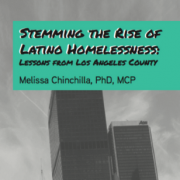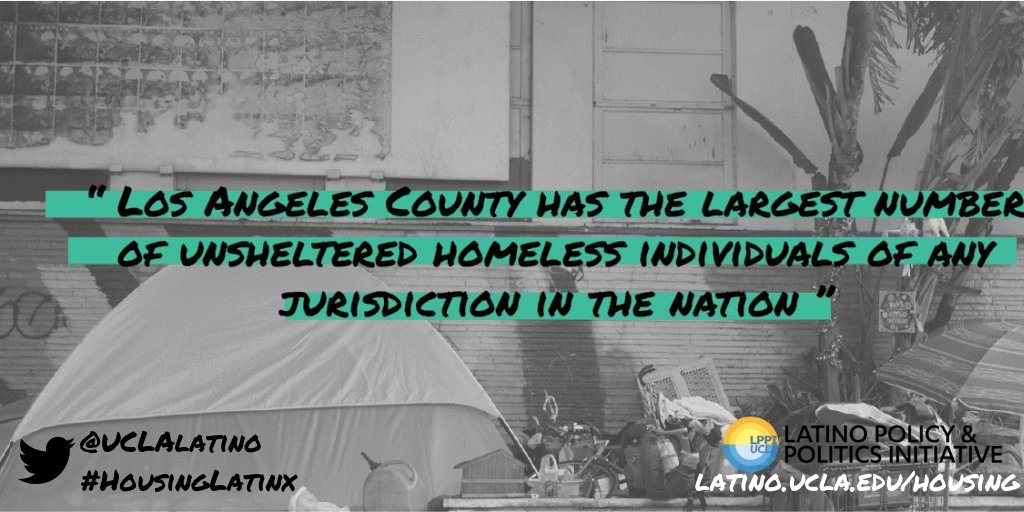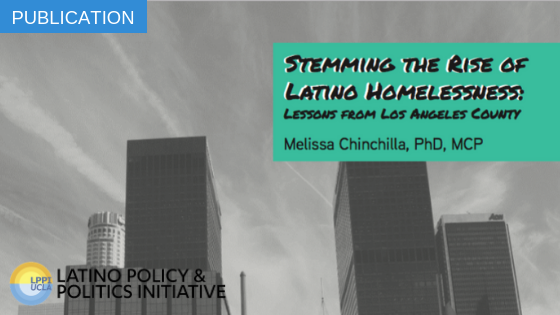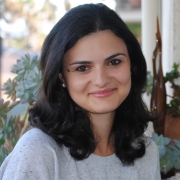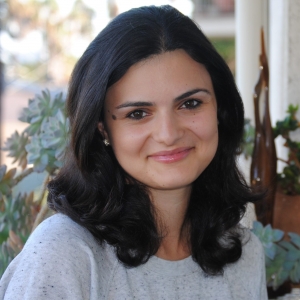Earlier this year, in collaboration with Dr. Melissa Chinchilla, PhD, MCP, the UCLA Latino Policy and Politics Initiative (LPPI) presented a critical look at the unique experience of Latino homelessness in Los Angeles County, the jurisdiction with the largest homeless population in the U.S. Stemming the Rise of Latino Homelessness: Lessons from Los Angeles County, identifies the social, political, and policy challenges facing Latinos. This report draws on two-dozen interviews with a cross-sector cadre of housing stakeholders to dissect the systemic issues that contribute to Latino housing insecurity and identify evidence-based policy solutions to improve opportunity and mobility for Latino families.
LPPI’s report finds that service providers struggle to serve limited English proficient populations and the current racially charged political landscape further discourages those most in need. “The issues affecting Latino homelessness mirror the societal issues affecting all but also are distinct to Latinos,” says Marco Santana, director of engagement at L.A. Family Housing. “There is the barrier of being a proud Latino and wanting to figure it out on your own, and the few times they reach out to access these societal safety nets, they’re met with the barrier of our current government and the fear of deportation or potentially being discriminated against by law enforcement.”
Latinos make up 48 percent of Los Angeles County’s population and 35 percent of the homeless population. Research and literature around homelessness finds that Latinos are likely to be undercounted in homeless counts because they rely on social networks rather than homeless services, are more likely to live in unstable and overcrowded households, and when living on the streets will settle in remote areas that are hard for service workers to reach. “The Latino Homeless community is one of the most vulnerable populations in Los Angeles that is often in the shadows and has not been a priority for many years,” says Raquel Román, program director at the Guadalupe Homeless Project of Dolores Mission in Los Angeles.
“Holding true to its mission to inform and improve the economic, political, and social landscape for Latinos, UCLA’s Latino Policy & Politics Initiative’s new report – Stemming the Rise of Latino Homelessness: Lessons from Los Angeles County – is sure to spark conversation, research, and coalition-building. In the face of a pressing affordable housing crisis and unprecedented federal hostility towards immigrants, this report provides a first look at an under-studied issue and offers targeted recommendations for future action and policy interventions in the field,” shares Los Angeles County Supervisor Mark Ridley-Thomas.
Leveraging the knowledge and experience of experts in the field, LPPI recommends both short and long-term policy solutions to address the unique cultural, linguistic, and socioeconomic needs of housing insecure Latinos. “There has been increasing recognition in recent years that in working to prevent and end homelessness, we must address the systems that perpetuate racial inequity,” stated Bill Pitkin, director of Domestic Programs for the Conrad N. Hilton Foundation. Pitkin adds, “This report provides an important contribution to those efforts by highlighting the particular causes of housing instability and homelessness among Latinos.”
Read the full report at: latino.ucla.edu/housing
About the UCLA Latino Policy and Politics Initiative:
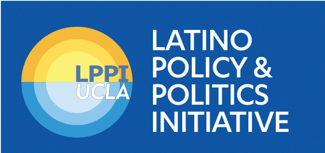 The Latino Policy & Politics Initiative (LPPI) is a comprehensive think tank that addresses the most critical domestic policy challenges facing communities of color in states and localities across the U.S. LPPI fosters innovative research, leverages policy-relevant expertise, drives civic engagement, and nurtures a leadership pipeline to propel viable policy reforms that expand opportunity for all Americans. Learn more at: latino.ucla.edu
The Latino Policy & Politics Initiative (LPPI) is a comprehensive think tank that addresses the most critical domestic policy challenges facing communities of color in states and localities across the U.S. LPPI fosters innovative research, leverages policy-relevant expertise, drives civic engagement, and nurtures a leadership pipeline to propel viable policy reforms that expand opportunity for all Americans. Learn more at: latino.ucla.edu

